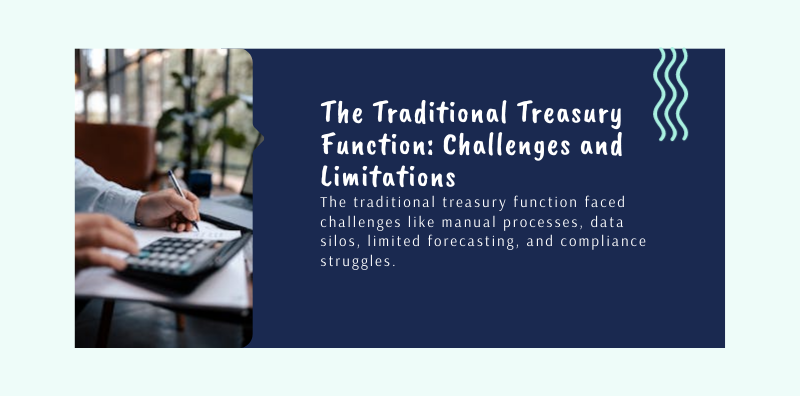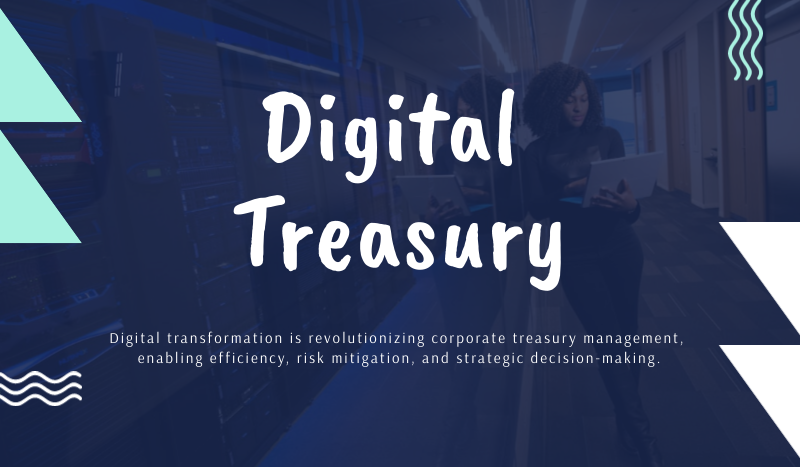Corporate treasury management, once characterized by manual spreadsheets and disjointed workflows, is undergoing a seismic shift. The catalyst? Digital transformation. As technology continues to reshape how businesses operate, corporate treasuries are increasingly turning to digital tools and platforms to boost efficiency, mitigate risks, and enhance decision-making.
This article explores the transformative impact of digitalization on corporate treasury management, examining the benefits, challenges, and future trends driving this evolution.

The Traditional Treasury Function: Challenges and Limitations
Before delving into digital transformation, it’s essential to understand the traditional role and inherent pain points of corporate treasury:
- Manual Processes: Reliance on spreadsheets, email communications, and legacy systems slows down operations and increases the risk of errors.
- Data Silos: Fragmented data across multiple systems hampers real-time visibility into cash positions and financial risks.
- Limited Forecasting Capabilities: Outdated tools often fail to support advanced cash flow forecasting and scenario planning.
- Compliance Struggles: Ensuring regulatory compliance manually is both time-consuming and error-prone.
These issues collectively hinder the treasury’s strategic potential and emphasize the need for digitization.
Defining Digital Transformation in Treasury
Digital transformation in treasury refers to the integration of digital technologies—such as cloud computing, automation, artificial intelligence (AI), and blockchain—into treasury operations to optimize performance, ensure compliance, and support strategic decision-making.
Key Technologies Driving Change
- Cloud-Based Treasury Management Systems (TMS): Enable centralized, real-time access to financial data and reduce reliance on IT infrastructure.
- Robotic Process Automation (RPA): Automates repetitive tasks such as payment processing, reconciliation, and reporting.
- Artificial Intelligence and Machine Learning: Enhance cash forecasting, risk assessment, and anomaly detection.
- Blockchain: Offers secure, transparent transaction records, improving payment processes and trade finance.
- API Integration: Ensures seamless data exchange between banking platforms, ERP systems, and treasury software.
Benefits of Treasury Digitalization
Digital transformation offers several compelling advantages:
1. Real-Time Visibility
Digitized treasuries can access real-time cash positions, improving liquidity management and enabling faster decision-making. This visibility is crucial for multinationals managing funds across numerous jurisdictions and currencies.
2. Enhanced Risk Management
With tools like AI and machine learning, treasurers can predict market risks, identify fraud patterns, and automate compliance checks, minimizing exposure to financial and operational threats.
3. Improved Efficiency
Automation reduces the manual workload, allowing treasury professionals to focus on strategic initiatives. This not only boosts productivity but also shortens cycle times for payments and reporting.
4. Better Decision-Making
Digital platforms consolidate data from multiple sources, offering insights through dashboards and analytics. This empowers treasurers to make informed decisions on investments, financing, and risk mitigation.
5. Regulatory Compliance
Digital solutions simplify regulatory reporting and audit readiness, helping organizations meet international standards like SOX, Basel III, and IFRS.
Strategic Role of the Modern Treasury in the Digital Era
As treasury departments embrace digital transformation, their role within the enterprise is evolving from a cost center to a strategic business partner. No longer confined to back-office operations, modern treasurers are now deeply involved in high-level decision-making that affects capital structure, investment planning, and enterprise risk.
Digital tools empower treasurers to become proactive value creators. For instance, advanced analytics platforms can simulate multiple funding scenarios, stress-test liquidity under different market conditions, and deliver recommendations based on predefined risk tolerance levels. This ability to anticipate and influence financial outcomes elevates the treasury’s relevance across departments, from procurement to investor relations.
Strategic Treasury Initiatives Enhanced by Digitalization
- Dynamic Cash Pooling: With real-time dashboards, treasurers can automate cash pooling across subsidiaries, optimizing liquidity utilization and minimizing idle balances.
- Intercompany Lending: Digital platforms allow centralized monitoring of intercompany loans, enabling effective interest rate management and tax planning.
- Capital Allocation: By integrating treasury data with strategic planning systems, businesses can align cash deployment with growth initiatives, M&A activity, and ESG investments.
Industry-Specific Applications of Digital Treasury
While the core principles of treasury remain consistent, industry-specific challenges demand tailored digital strategies. Here’s how various sectors are leveraging digital treasury tools:
1. Manufacturing
Manufacturers operate in capital-intensive environments with global supply chains. Treasury teams in this sector use digital platforms to optimize working capital, manage currency exposures, and support just-in-time financing models. Predictive analytics help anticipate raw material price fluctuations, ensuring smoother budgeting and procurement.
2. Retail
Retailers face seasonality, tight margins, and a mix of digital and physical payments. Treasury tools integrated with point-of-sale (POS) systems enable real-time reconciliation and fraud detection. Retail treasurers can also use AI to model peak season cash requirements and optimize payment cycles with vendors.
3. Technology
In tech companies, treasury often handles large foreign cash balances and equity compensation programs. Blockchain is increasingly used to automate payments to global contractors, while scenario planning tools assist in planning for IPOs, stock buybacks, or cross-border acquisitions.
4. Energy and Utilities
With long project timelines and commodity-linked revenues, energy companies leverage treasury technology to manage interest rate and FX derivatives, track project financing, and assess climate-related financial risk through ESG-linked dashboards.
The Impact of Embedded Finance and Open Banking
A game-changing trend in digital treasury is the rise of embedded finance and open banking APIs. These innovations blur the lines between traditional banking and digital platforms, enabling businesses to embed banking services directly into their internal systems.
Benefits of Embedded Finance in Treasury
- Faster Payment Initiation: Treasurers can execute payments from ERP systems without logging into bank portals.
- Instant Cash Positioning: API-based bank feeds provide real-time cash updates, improving investment decisions.
- Enhanced Treasury-as-a-Service (TaaS): Businesses can plug in treasury functions like FX hedging or liquidity optimization as services via API.
Open banking also fosters greater financial interoperability, particularly valuable for multinationals managing diverse banking relationships across regions. With APIs, treasury can automate bank fee analysis, compliance monitoring, and regulatory reporting, reducing administrative burden.
The Role of Digital Identity and Cybersecurity
As treasury functions go digital, cybersecurity and digital identity become non-negotiable. Financial data and payment infrastructures are prime targets for cyber threats, making secure access control and encryption essential components of any digital treasury strategy.
Key Cybersecurity Practices
- Multi-Factor Authentication (MFA): Reduces the risk of unauthorized access to sensitive financial systems.
- Real-Time Fraud Detection: AI-driven algorithms flag suspicious transactions, reducing exposure to internal and external fraud.
- Tokenization and Digital Signatures: These provide secure transaction authorization, especially in high-volume or high-value environments.
Treasury teams must work closely with IT and compliance departments to create robust cyber resilience frameworks that align with digital operations.
Treasury Innovation Through Fintech Collaboration
Corporate treasuries are increasingly engaging with fintechs to accelerate innovation. Unlike traditional banks, fintechs offer modular, agile solutions that integrate quickly with existing systems.
Common Fintech Use Cases in Treasury
- Cash Forecasting Tools: Startups like Trovata and Cashforce use machine learning to provide rolling, real-time forecasts.
- Trade Finance Platforms: Blockchain-enabled fintechs simplify document processing, lowering transaction times and costs.
- Cross-Border Payments: Companies like Wise and Ripple offer cost-effective alternatives to SWIFT for international payments.
Collaborating with fintechs gives treasuries access to cutting-edge capabilities without overhauling their entire infrastructure—a critical advantage for organizations navigating digital transformation on a budget.
ESG and Sustainable Finance in Treasury
As environmental, social, and governance (ESG) concerns gain prominence, treasury teams are being called upon to integrate sustainability principles into their financial practices.
ESG-Driven Treasury Initiatives
- Green Bonds: Treasuries are issuing and managing green debt instruments to finance sustainable projects.
- ESG KPIs in Banking Agreements: Companies are tying financing rates to sustainability metrics, incentivizing ESG performance.
- Carbon Accounting Integration: Digital treasury platforms now include carbon tracking tools to align cash deployment with environmental goals.
With regulators and investors demanding transparency, digital platforms that support ESG data collection and reporting are becoming indispensable for future-ready treasury teams.
Roadmap to Digital Treasury Transformation
Embarking on digital transformation requires a structured approach:
1. Assess Current State
Conduct a comprehensive audit of current treasury processes, systems, and capabilities to identify pain points and opportunities for improvement.
2. Define a Clear Vision
Establish goals aligned with business strategy—whether it’s improving forecasting, enhancing compliance, or scaling globally.
3. Select the Right Technology
Choose technologies that integrate seamlessly with existing ERP systems, support scalability, and align with cybersecurity protocols.
4. Change Management
Invest in training, involve stakeholders early, and foster a culture of innovation to ensure successful adoption.
5. Monitor and Optimize
Track KPIs such as processing time, forecast accuracy, and user satisfaction to continuously refine processes.
Challenges to Anticipate
Despite its benefits, digital treasury transformation is not without hurdles:
- Integration Complexity: Ensuring seamless integration with legacy systems can be resource-intensive.
- Data Security: As digital tools expand access to sensitive financial data, cybersecurity becomes paramount.
- Change Resistance: Treasury teams accustomed to manual processes may resist new tools.
- Budget Constraints: High initial investment may deter some organizations, despite long-term savings.
Emerging Trends in Digital Treasury
Looking forward, several trends will shape the next phase of digital treasury evolution:
AI-Powered Decision Support
AI will evolve from forecasting to prescriptive analytics, offering actionable recommendations on investments, funding, and risk hedging.
Real-Time Payments
Instant payment systems like SWIFT gpi and ISO 20022 are redefining payment expectations, making real-time treasury a reality.
Decentralized Finance (DeFi)
While still nascent, DeFi platforms may influence corporate treasury by offering new forms of liquidity and yield generation.
ESG Integration
Treasury departments are beginning to integrate Environmental, Social, and Governance (ESG) factors into their investment and financing decisions, supported by digital tracking tools.
Best Practices for a Successful Transformation
To maximize ROI, corporate treasuries should follow these best practices:
- Start Small, Scale Fast: Pilot projects allow organizations to test technologies and demonstrate quick wins.
- Collaborate with IT and Finance: Cross-functional collaboration ensures alignment and efficient deployment.
- Prioritize Data Quality: Accurate, clean data is the backbone of any digital system.
- Invest in Talent: Upskill treasury teams to leverage advanced tools and interpret data effectively.
Digital transformation is not a buzzword—it’s a business imperative for corporate treasury management. As global finance becomes increasingly complex, digital tools provide the agility, accuracy, and insight required to navigate this new landscape.
For companies willing to embrace innovation, the payoff includes enhanced control, optimized liquidity, and strategic value generation. Treasury departments that resist the shift risk falling behind, not just technologically, but competitively.








